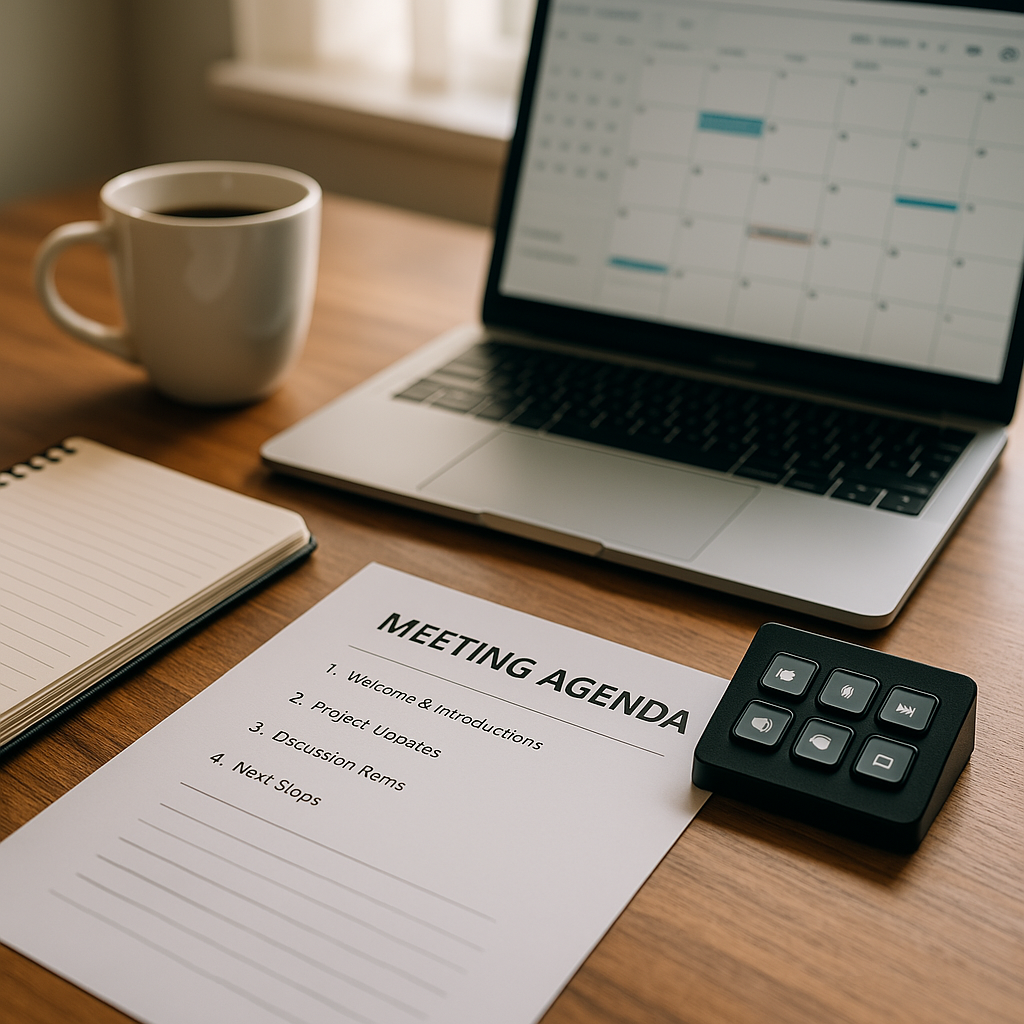Pre-Meeting Success Strategies
The foundation of any successful meeting is laid before anyone joins the call. This section will guide you through creating the optimal conditions for productive, engaging virtual meetings.
On this page
- Loading table of contents...
Crafting the perfect agenda
A well-crafted agenda is the backbone of an effective meeting. It serves as a roadmap, guiding participants through discussions with purpose and clarity. Without a thoughtful agenda, meetings can meander aimlessly, waste valuable time, and leave participants frustrated by lack of progress or unclear outcomes.
Creating an effective agenda involves more than just listing topics—it requires strategic thinking about goals, priorities, timing, and participant engagement. A great agenda signals professionalism and respect for participants' time while also creating the conditions for productive collaboration. When distributed in advance, it allows participants to prepare appropriately and arrive ready to contribute meaningfully.
The following components transform an ordinary topic list into a powerful meeting tool. Including these elements in your agenda will significantly enhance meeting focus, participation, and outcomes. Consider creating a standard template incorporating these components to streamline your preparation process for recurring meetings.

Key components of a powerful agenda:
- Clear objectives statement - Define what you aim to accomplish in one concise sentence
- Topic hierarchy - List items in order of importance, not chronology
- Time allocations - Assign specific minutes to each agenda item
- Ownership assignments - Note who will lead each discussion point
- Preparation requirements - Specify what participants should review beforehand
- Decision points - Highlight items requiring decisions
- Input vs. information - Distinguish between topics needing feedback and pure updates
The magic number for agenda items
Research suggests that 3-5 substantial topics is ideal for a 60-minute meeting. This aligns with cognitive psychology findings that people process information most efficiently in small clusters.
For longer meetings (90+ minutes), consider the "7±2 rule" from cognitive science, which indicates most people can hold 5-9 items in working memory.
Pro tip: For each 30 minutes of meeting time, aim for no more than 2-3 substantive agenda items.
Setting clear expectations
Setting expectations isn't just good manners—it's the foundation of meeting efficiency and effectiveness. When participants have different assumptions about a meeting's purpose, process, or outcomes, confusion and frustration inevitably follow. Clear expectations create alignment, focus attention on shared goals, and establish the parameters for productive interaction.
Expectation setting happens at multiple points in the meeting lifecycle. It begins with the initial invitation, continues through pre-meeting communications, and gets reinforced at the meeting's start. Each touchpoint provides an opportunity to clarify what participants should anticipate and what's expected of them.
The following guidelines will help you establish clear expectations at different stages of the meeting process. By implementing these practices consistently, you'll create more purposeful, efficient meetings and reduce the common friction points that waste time and energy.
Before the meeting:
- Communicate the purpose clearly - Explain why this meeting is necessary
- Define what "done" looks like - Specify the desired outcomes
- Specify roles and responsibilities - Clarify who's leading, taking notes, etc.
- Set the tone - Indicate if this is for decision-making, brainstorming, or updates
At the start of the meeting:
- Reiterate the purpose - State the meeting's objective in one sentence
- Establish ground rules - Cover participation norms and technology expectations
- Preview the agenda - Walk through timing and topics briefly
- Clarify decision processes - Explain how conclusions will be reached
Expectation-setting mistakes to avoid:
- Assuming shared vision - Not everyone may share your idea of success
- Vague preparation guidance - Be specific about what to read or prepare
- Neglecting to mention recording - Always inform if recording will occur
- Unclear on multitasking - State expectations about focused attention
The art of the pre-read
The pre-read is your secret weapon for meeting efficiency. Rather than spending valuable meeting time bringing everyone up to speed, a well-crafted pre-read allows you to jump straight into meaningful discussion. This approach transforms meetings from information-sharing sessions into collaborative problem-solving and decision-making forums.
Pre-reads are particularly valuable for complex topics that require careful consideration, data-intensive discussions, or scenarios where participants need time to process information before forming opinions. They help level the playing field for different thinking styles—giving reflective thinkers time to process information and prepare their thoughts before being put on the spot.
However, not all pre-reads are created equal. Sending lengthy, unfocused documents with vague instructions often results in poor preparation or participants skipping the reading entirely. An effective pre-read should be concise, focused on essential information, and explicitly connected to the meeting's objectives.
Elements of an effective pre-read:
- Context - Briefly explain why this topic matters
- Essential background - Provide only necessary information
- Key data points - Include critical metrics or findings
- Questions to consider - Guide participants' thinking before they arrive
- Expected outcomes - Clarify what you hope to achieve in the meeting
Pre-read best practices:
- Timing: Share 24-48 hours before the meeting
- Length: Aim for 1-2 pages (5-minute read)
- Format: Use headings, bullet points, and visual elements
- Follow-up: Begin the meeting with a 3-minute silent review period
Pro tip: If your pre-read exceeds two pages, include an executive summary at the top.

Choosing the right participants
The "two-pizza rule" popularized by Jeff Bezos suggests that teams should be small enough to be fed by two pizzas—typically 5-8 people. This principle applies perfectly to meetings, where size directly impacts quality. Every additional participant increases complexity exponentially, affecting everything from scheduling difficulties to participation imbalances.
Thoughtful participant selection is often overlooked, yet it's one of the most powerful levers for meeting effectiveness. Too few participants may leave out crucial perspectives or decision-makers, while too many can slow progress and dilute individual contribution. The right participants create the conditions for efficient decision-making, candid discussion, and appropriate expertise.
Beyond just numbers, consider the mix of roles, personalities, and expertise. Successful meetings often benefit from cognitive diversity while maintaining a clear purpose that's relevant to everyone invited. Remember that not everyone who might be interested needs to attend—there are often more efficient ways to keep people informed without requiring their presence.
Participant selection criteria:
- Decision makers - Those who can approve outcomes
- Subject matter experts - People with essential knowledge
- Implementers - Those who will execute on decisions
- Representatives - One person per stakeholder group
Categories to consider:
- Required - The meeting cannot achieve its purpose without them
- Contributory - Will add valuable perspective
- Informational - Should be aware but can receive notes instead
- Courtesy - Invited for political reasons but optional
Pro tip: For each potential attendee, ask: "What specific value will this person add to the conversation? What would we miss without them?"
Finding the optimal meeting time
Research shows that meeting timing can significantly impact attendance, engagement, and decision quality. The human brain follows natural cycles of energy and focus throughout the day, and these patterns affect our capacity for different types of thinking and interaction. Additionally, organizational rhythms and personal routines create common patterns of availability and focus that wise schedulers take into account.
Timing considerations become even more complex with distributed teams spanning multiple time zones. What might be prime meeting time for one location could be early morning or late evening for another. Cultural differences around working hours and lunch breaks add another layer of complexity to finding truly optimal times.
While there's no one-size-fits-all solution, research and experience have revealed certain patterns that can guide your scheduling decisions. The following guidelines can help you select times that maximize the likelihood of productive, engaged participation based on the specific purpose of your meeting.
Best times for different meeting types:
- Decision-making meetings: 9-11 AM when energy and focus are high
- Creative brainstorming: 3-4 PM when minds are more relaxed and open
- Status updates: Early afternoon (2 PM) for quick check-ins
- Complex problem-solving: Morning, ideally Tuesday-Thursday
- Team building: Late afternoon or end of week
Factors to consider:
- Time zones - Find overlaps that don't require anyone to be up at 3 AM
- Attention cycles - Avoid post-lunch (1-2 PM) energy dips
- Meeting density - Check calendars for "meeting fatigue" days
- Buffer time - Allow 15-30 minutes between meetings
Host preparation checklist
As a meeting host, your preparation sets the tone for success. The time you invest before the meeting has a multiplying effect—every minute of preparation can save many minutes of meeting time and improve outcomes substantially. Thorough preparation demonstrates respect for participants' time and creates confidence in your leadership.
Preparation involves more than just creating an agenda. It requires thoughtful consideration of objectives, materials, technology, and potential challenges. The best hosts anticipate needs, remove obstacles, and create conditions for productive collaboration before anyone joins the call.
The following checklist provides a comprehensive framework for meeting preparation at different timeframes before the meeting. While not every item will apply to every meeting, this structured approach ensures you don't overlook critical elements.
1-2 days before:
- Finalize and distribute agenda
- Send pre-read materials
- Confirm critical participants' attendance
- Prepare visual aids or presentations
- Set up collaborative documents
1 hour before:
- Review agenda and objectives
- Test technology (camera, microphone, screen sharing)
- Arrange your background and lighting
- Open necessary documents and applications
- Review participant list and key contributions needed
5 minutes before:
- Join early to greet participants
- Have agenda visible and ready to share
- Check audio and video once more
- Close unnecessary applications and notifications
- Take a moment to center yourself
Understanding the true cost of meetings
Meetings are one of the largest untracked expenses in most organizations. When we fail to calculate their actual cost, we tend to overuse this tool and underinvest in making meetings effective. The financial impact of inefficient meetings is staggering when properly quantified—yet most organizations track office supplies more carefully than they monitor meeting expenses.
Beyond the direct salary costs of participants' time, meetings incur opportunity costs (what people could be accomplishing instead), preparation expenses, and often hidden costs of delayed decisions or poor-quality outcomes. When viewed holistically, meetings represent a major organizational investment that deserves careful stewardship.
Calculating and communicating meeting costs isn't about discouraging necessary collaboration. Rather, it creates appropriate gravity around meeting decisions, encourages more selective scheduling, and justifies investments in improving meeting effectiveness.
The meeting cost formula:
Meeting Cost = (Average Hourly Rate × Number of Participants × Meeting Duration) + Opportunity Cost
For example:
- 8 participants at an average rate of $50/hour
- 60-minute meeting
- Base cost: $400
- Add opportunity cost (what could have been accomplished otherwise)
- Total cost: $600-800
Measuring meeting ROI:
For a meeting to be worthwhile, the value created should exceed its cost. Ask:
- What tangible outcomes were achieved?
- What decisions were made that moved projects forward?
- How much would it have cost to achieve these outcomes another way?
- What future costs were avoided by holding this meeting?
Pro tip: Occasionally calculate and share the cost of a recurring meeting with participants. This creates awareness and often improves focus and efficiency.
About MuteDeck
MuteDeck is your shortcut to smoother, less stressful meetings. It keeps your mic, camera, and screen sharing under control on any platform.
Get the free trial at mutedeck.com.